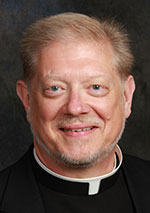That All May Be One / Fr. Rick Ginther
Celebration takes priest back to his Judeo-Christian roots
 I first attended Congregation Beth-El Zedeck (The House of the God of Righteousness) in 1966.
I first attended Congregation Beth-El Zedeck (The House of the God of Righteousness) in 1966.
Father John Rocap, my junior-year religion teacher at the Latin School in Indianapolis, invited our class to attend a bar mitzvah.
In a way, he was introducing us to our Jewish roots. And he was opening us to the depth and breadth of “Nostra Aetate,” the 1965 Vatican II document on relations with other religions.
For me, it was a beginning of a curiosity for and connectivity to my Judeo-Christian roots.
Fast forward to Oct. 8, 2019. I am at the same location, Congregation Beth-El Zedeck, for another Jewish religious celebration: Yom Kippur.
The Jewish New Year, Rosh Hashanah, occurs annually in September or October. Spanning nine days, it culminates with the 10th day, Yom Kippur, the Day of Atonement.
For observant Jews, the new year is a time of personal and religious “new beginnings.” The past year is reviewed. Promises made are examined. Those fulfilled are noted. Those unfulfilled call for repentance. For sins against God, atonement is sought. For sins against persons, reconciliation with the one offended is to be sought before atonement is possible.
And God provides that “at-one-ment,” so that the new year may unfold with blessings and peace rooted in the “at-one-ment.”
The first solemn service of Yom Kippur began at 6:45 p.m. Seated next to me was Rabbi Emeritus Sandy Sasso and Jesuit Father Bill Verbryke, president of Brebeuf Jesuit Preparatory School. Rabbi Sandy and her husband, Rabbi Dennis Sasso, had invited us to attend. They were gracious, welcoming hosts, as were many others of the congregation whom we met.
Yom Kippur is a full 24 hours of prayer and fasting. There are five services. The first is Kol Nidre.
Kol Nidre is the prelude to the Evening Service which follows. The Kol Nidre is an ancient renunciation of promises.
With this renunciation complete, a violin and organ provided haunting music of the same name. Sorrow, longing for forgiveness and peace poured forth.
The Evening Service then moved through its many sections: Half-Kaddish (praise of God’s name); the Shema (“Hear O Israel, the Lord our God is Lord alone”); the Amidah (prayer of blessings); the Al Chet confession of sins, and special additional prayers particular to Yom Kippur.
During the Al Chet, sins (hamartia, Hebrew for “missing the mark”) were confessed as a body. The word “I” was not used, but rather “we.” This reflected Judaism’s corporate sense of sin; all bear responsibility together.
Each section contained beautifully recited and chanted exchanges between cantor, choir and congregation. I could hear the roots of our own Catholic psalm intonations with their call and response.
More than once during the service, the Ark, which is an in-wall “holy space” that holds the Torah, was opened. All stood each time it was opened.
During the initial opening, select elders—men and women—came forward to the Ark. Each was handed a scroll.
They stood around what we might call an “altar.” Bravely, stoutly, they bore the literal weight of the scrolls and their divine meaning. When the cantor and congregation’s chanting ended, the scrolls were returned to the Ark.
When the service ended, we had been at prayer for two hours! For me, this time passed as “Kairos” or “God” time. I have experienced such time at many an Easter Vigil!
It was a privilege and blessing to witness this time of prayer, the faith underlying it, and the vibrancy of the congregation. May my hosts enjoy a happy new year!
(Father Rick Ginther is director of the archdiocesan Office of Ecumenism and Interreligious Affairs. He is pastor of Our Lady of Lourdes Parish, Indianapolis.) †
 I first attended Congregation Beth-El Zedeck (The House of the God of Righteousness) in 1966.
I first attended Congregation Beth-El Zedeck (The House of the God of Righteousness) in 1966.